|
 he
1904 World’s Fair: Looking Back at Looking Forward
boasts seven exciting, artifact-rich sections. he
1904 World’s Fair: Looking Back at Looking Forward
boasts seven exciting, artifact-rich sections.
CONSTRUCTING THE FAIR
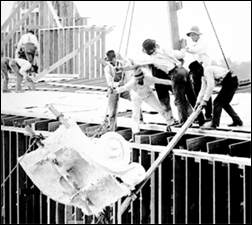 The
opening of the Louisiana Purchase Exposition followed several
years of preparation that included the development of surrounding
neighborhoods, improvements to the city’s water supply, and
the clearing of parkland. The great enterprise that unfolded
in St. Louis in 1904 brought together the achievements of
science, art, and industry that helped define the advent of
the twentieth century. The story behind the construction of
the Louisiana Purchase Exposition is one of human perseverance—a
testimony to the energy, investment, and commitment of the
citizens of St. Louis. The Fair was a highly orchestrated
event, with its designers joining ranks with civic planners
and an army of more than 10,000 laborers to transform over
1,200 acres of thickets and swamps in Forest Park and Clayton
into a grand landscape filled with classically inspired buildings,
waterways, gardens, anavenues. While the 1904 World’s Fair
celebrated the one-hundredth anniversary of the Louisiana
Purchase, the renovated parkland told a story of American
progress since 1804. The
opening of the Louisiana Purchase Exposition followed several
years of preparation that included the development of surrounding
neighborhoods, improvements to the city’s water supply, and
the clearing of parkland. The great enterprise that unfolded
in St. Louis in 1904 brought together the achievements of
science, art, and industry that helped define the advent of
the twentieth century. The story behind the construction of
the Louisiana Purchase Exposition is one of human perseverance—a
testimony to the energy, investment, and commitment of the
citizens of St. Louis. The Fair was a highly orchestrated
event, with its designers joining ranks with civic planners
and an army of more than 10,000 laborers to transform over
1,200 acres of thickets and swamps in Forest Park and Clayton
into a grand landscape filled with classically inspired buildings,
waterways, gardens, anavenues. While the 1904 World’s Fair
celebrated the one-hundredth anniversary of the Louisiana
Purchase, the renovated parkland told a story of American
progress since 1804.
To experience more related to Constructing
the Fair, visit the Artifacts
Section.
NATIONS ON DISPLAY
More foreign nations participated in the Louisiana Purchase
Exposition than in 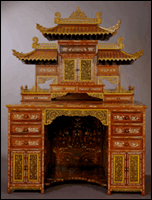 any
preceding World’s Fair. Whether from Western Europe or the
Far East, delegations from each country designed their exhibits
to stress technological and cultural advances, as well as
pride in their national history. Examples of handcrafted and
manufactured goods, many ready for export, were also featured,
reinforcing the prospect of a new global marketplace. During
the summer of 1904, St. Louis became the heart of a consumer
world market, the forefront of technological and educational
advancement and a museum for international history. any
preceding World’s Fair. Whether from Western Europe or the
Far East, delegations from each country designed their exhibits
to stress technological and cultural advances, as well as
pride in their national history. Examples of handcrafted and
manufactured goods, many ready for export, were also featured,
reinforcing the prospect of a new global marketplace. During
the summer of 1904, St. Louis became the heart of a consumer
world market, the forefront of technological and educational
advancement and a museum for international history.
To experience more related to Nations
on Display, visit the Artifacts
Section.
PEOPLE AT THE FAIR
 People
came to the World’s Fair for a variety of reasons: to visit
and marvel, to work, or to be displayed. The variety of groups
created a vast global village, where people’s appearances
often defined their place within a presumed hierarchy of civilization.
American Indians, Filipinos, and other "primitives" from the
Far East and South America were invited to participate as
"living displays." They provided fairgoers with a rare, firsthand
encounter with peoples from far-off lands. People
came to the World’s Fair for a variety of reasons: to visit
and marvel, to work, or to be displayed. The variety of groups
created a vast global village, where people’s appearances
often defined their place within a presumed hierarchy of civilization.
American Indians, Filipinos, and other "primitives" from the
Far East and South America were invited to participate as
"living displays." They provided fairgoers with a rare, firsthand
encounter with peoples from far-off lands.
Although understood today as an expression of the Fair organizers’
blatant racism, at the time the Anthropology Department’s
"living displays" reaffirmed the basic belief in the superiority
of industrial civilization, which lay at the core of the Exposition’s
appeal.
To experience more related to People
at the Fair, visit the Artifacts
Section.
ART AT THE FAIR
 As
Louisiana Purchase Exposition company President David R. Francis
noted in his history of the 1904 World’s Fair: As
Louisiana Purchase Exposition company President David R. Francis
noted in his history of the 1904 World’s Fair:
“At
no previous exposition did art receive so much recognition
and attention.”
Painters, sculptors and applied artists from twenty-seven
nations filled the Palace of Fine Arts with objects meant
to inspire and instruct. Other state buildings and foreign
exhibits across the fairgrounds also displayed art to emphasize
the value of creative expression in daily life. Amidst these
wide-ranging venues for art, St. Louis artists made valuable
contributions, reinforcing the city’s aspiration to be a national
center for the arts.
To experience more related to Art
at the Fair, visit the Artifacts
Section.
VIEWING THE FAIR
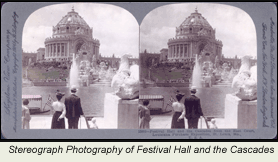 The
landscape of the Louisiana Purchase Exposition was a carefully
controlled environment— designed by architects, built
by laborers, represented by artists and photographers, reproduced
in souvenirs, and promoted in the media. In nearly every printed
account there appeared a fascination with how the fairgrounds
should be viewed. When describing their experiences, authors
inevitably settled on such terms as glance, gaze,
picture, and framing the view. The countless
number of postcards, photographs, and artworks reinforced
that way of thinking. Views of the space and architecture
of Forest Park were presented as a magnificent picture. How
people viewed the fairgrounds required visual instruction
that served not only as a map of what to “see” at the World’s
Fair, but also as a souvenir—a physical memory—of America’s
great democratic experiment. The
landscape of the Louisiana Purchase Exposition was a carefully
controlled environment— designed by architects, built
by laborers, represented by artists and photographers, reproduced
in souvenirs, and promoted in the media. In nearly every printed
account there appeared a fascination with how the fairgrounds
should be viewed. When describing their experiences, authors
inevitably settled on such terms as glance, gaze,
picture, and framing the view. The countless
number of postcards, photographs, and artworks reinforced
that way of thinking. Views of the space and architecture
of Forest Park were presented as a magnificent picture. How
people viewed the fairgrounds required visual instruction
that served not only as a map of what to “see” at the World’s
Fair, but also as a souvenir—a physical memory—of America’s
great democratic experiment.
To experience more related to Viewing
the Fair, visit the Artifacts
Section.
SHOPPING AT THE FAIR
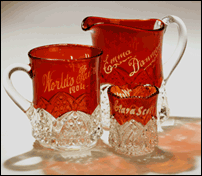 Just
as contemporary vacationers are bombarded with trinkets and
t-shirts to commemorate their trip to a theme park or a resort,
the opportunity to shop at the World’s Fair dominated
the visitor experience in 1904. More than 500 concession stands
dotted the fairgrounds where visitors could examine and then
purchase products made as new labor-saving devices for their
home or business. Exhibits in nearly every palace and building
also made it clear that the souvenir business was an industry
unto itself. Companies vied for the “Official Souvenir”
contracts and fought for the best positions at the Fair for
selling their wares. As part of a growing commercial center,
St. Louis companies took advantage of this opportunity. Shoe
manufacturers, automotive companies, beverage distributors,
and many other local businesses used the Fair to launch new
products and embrace the millions of potential customers. Just
as contemporary vacationers are bombarded with trinkets and
t-shirts to commemorate their trip to a theme park or a resort,
the opportunity to shop at the World’s Fair dominated
the visitor experience in 1904. More than 500 concession stands
dotted the fairgrounds where visitors could examine and then
purchase products made as new labor-saving devices for their
home or business. Exhibits in nearly every palace and building
also made it clear that the souvenir business was an industry
unto itself. Companies vied for the “Official Souvenir”
contracts and fought for the best positions at the Fair for
selling their wares. As part of a growing commercial center,
St. Louis companies took advantage of this opportunity. Shoe
manufacturers, automotive companies, beverage distributors,
and many other local businesses used the Fair to launch new
products and embrace the millions of potential customers.
To experience more related to Shopping
at the Fair, visit the Artifacts
Section.
THE 1904 OLYMPICS
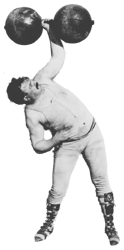 The
1904 World’s Fair served as host to the 1904 Olympic Games—the
first Olympics to be held in the United States since the ancient
event’s 1896 revival. The official games took place August
29 through September 3, 1904, predominantly at Francis Field,
the stadium on the campus of Washington University. Throughout
the course of the World’s Fair, numerous other athletic events
and contests occurred under the guise of the Olympics in order
to boost the public’s interest and participation. More than
simply competitive events, the 1904 Olympics served as a demonstration
of the health benefits of physical exertion both for individuals
and nations. The
1904 World’s Fair served as host to the 1904 Olympic Games—the
first Olympics to be held in the United States since the ancient
event’s 1896 revival. The official games took place August
29 through September 3, 1904, predominantly at Francis Field,
the stadium on the campus of Washington University. Throughout
the course of the World’s Fair, numerous other athletic events
and contests occurred under the guise of the Olympics in order
to boost the public’s interest and participation. More than
simply competitive events, the 1904 Olympics served as a demonstration
of the health benefits of physical exertion both for individuals
and nations.
To experience more related to The
1904 Olympics, visit the Artifacts
Section.
|


